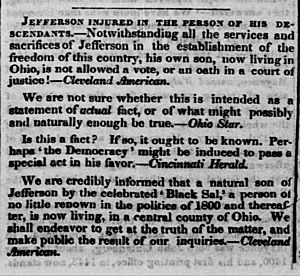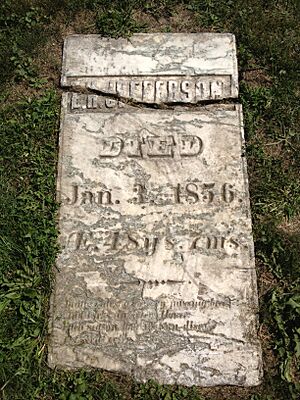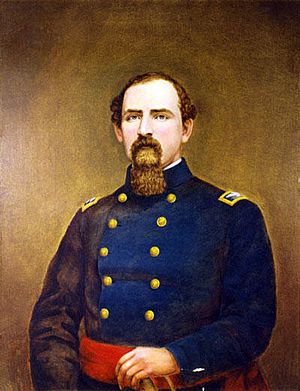Eston Hemings facts for kids
Quick facts for kids
Eston Hemings Jefferson
|
|
|---|---|
| Born |
Eston Hemings
May 21, 1808 Monticello, Virginia, U.S.
|
| Died | January 3, 1856 (aged 47) Madison, Wisconsin, U.S.
|
| Occupation | Carpenter, musician |
| Spouse(s) |
Julia Ann Isaacs
(m. 1832) |
| Children | 3, including John Wayles Jefferson |
| Parent(s) | Sally Hemings Thomas Jefferson |
| Relatives | Beverley Hemings (brother), Harriet Hemings (sister), Madison Hemings (brother) |
Eston Hemings Jefferson (born May 21, 1808 – died January 3, 1856) was born into slavery. He was the youngest son of Sally Hemings, an enslaved woman of mixed race, at Monticello. Most historians believe his father was Thomas Jefferson, the third President of the United States.
A DNA test in 1998 showed a connection between Eston's descendants and the Jefferson family. This, along with historical records, strongly suggests Thomas Jefferson was Eston's father. Many historians think Jefferson and Sally Hemings had six children together. Four of these children lived to be adults.
Thomas Jefferson's will freed Eston and his older brother, Madison Hemings. They were still young when Jefferson died. After gaining freedom, they lived with their mother, Sally, in Charlottesville, Virginia. After Sally's death in 1835, both brothers moved their families to Chillicothe, Ohio. They chose Ohio because it was a free state where slavery was not allowed. In Ohio, Eston Hemings worked as a musician and entertainer.
In 1852, Eston moved again with his wife and three children. They settled in Madison, Wisconsin. There, they changed their last name to Jefferson. They became part of the white community. Eston's sons later fought in the Union Army during the Civil War. His oldest son, John Wayles Jefferson, became a colonel. He later moved to Memphis, Tennessee, and became a successful cotton broker.
Contents
Eston's Early Life
We know about Eston's early life from a few sources. His brother Madison wrote a memoir in 1873. There are also notes in Thomas Jefferson's Farm Book. Some old newspaper articles and family records also provide information.
Eston was born into slavery as the youngest son of Sally Hemings. Sally was one of six mixed-race children of Betty Hemings and John Wayles. John Wayles was also Jefferson's father-in-law. This meant Sally and her siblings were half-siblings to Jefferson's wife, Martha Wayles. They were mostly European in their background.
Historians have noted many mixed-race relationships in these families. The large Hemings family was important at Monticello. They worked as house servants, chefs, and skilled workers. Eston and his siblings had lighter duties as children. They were allowed to stay near the "great house." They only did simple tasks like running errands.
Like their older brother Beverley, Madison and Eston started training in carpentry at age 14. Their uncle, John Hemings, was a master woodworker at Monticello. All three brothers also learned to play the violin. Thomas Jefferson himself played the violin when he was younger.
Madison and Eston were freed in 1827. This was stated in President Jefferson's will. Madison was 22, and Eston was 19 when they became free. Jefferson's will also asked the government to let the Hemingses stay in Virginia. This was unusual, as most freed slaves had to leave the state. Madison later said that Jefferson freed them because of a promise he made to Sally Hemings.
After Jefferson died, his daughter allowed Sally Hemings to live freely. Sally lived with her two sons in Charlottesville. In the 1830 census, the census taker listed all three Hemings as white. This shows how light-skinned they appeared due to their European ancestry. Sally was three-quarters white. Her children were seven-eighths white. Under Virginia law at the time, this meant they were legally white.
Life After Slavery
After gaining his freedom, Eston Hemings first worked as a carpenter in Charlottesville, Virginia. In 1830, he bought land and built a house on Main Street. His mother lived with him there until she passed away in 1835.
Marriage and Family Life
In 1832, Eston married Julia Ann Isaacs (1814–1889). She was a free woman of color. Julia's father was David Isaacs, a successful Jewish merchant from Germany. Her mother was Nancy West, a free woman of mixed race. Nancy's mother was Priscilla, a former slave, and her father was Thomas West, a white man. Thomas West left property to his children, Nancy and James West, in his will. David Isaacs and Nancy West could not legally marry. They kept separate homes and businesses for many years. Nancy was a successful baker. They had seven children together. Later in their lives, they did share a home.
Eston and Julia Ann Hemings had three children:
- John Wayles Jefferson (1835–1892)
- Anna Wayles Jefferson (1837–1866)
- Beverly Frederick Jefferson (1839–1908)
John and Anna were born in Charlottesville. Beverly was born in Ohio shortly after the family moved there. The family changed their last name from Hemings to Jefferson after moving to Wisconsin.

Around 1837, Eston moved his family to Chillicothe, Ohio. This town was in a free state. It had a strong community of free black people and white abolitionists. These groups helped enslaved people escape through the Underground Railroad. In Chillicothe, Eston became a professional musician. He played the violin and led a popular dance band. His children went to integrated schools. Anna even attended the Manual Labor School at Albany, Ohio for a time. A former classmate later said Anna was introduced as "Miss Anna Heming[s], the grand daughter of Thomas Jefferson."
In a 1902 newspaper article, a writer recalled Eston living in Ohio in the 1840s. It was widely known then that Eston and his brother Madison were said to be Thomas Jefferson's sons. Some of Eston's neighbors had visited Washington, D.C. They saw a statue of Jefferson and noted how much Eston looked like him. The writer also remembered:
Eston Hemings, being a master of the violin, and an accomplished "caller" of dances, always officiated at the "swell" entertainments of Chillicothe.
The Fugitive Slave Act was passed in 1850. This law made life harder for black communities in free states near slave states. Slave catchers would enter these towns. They sometimes kidnapped free people and sold them into slavery. In 1852, Eston decided to move his family further north for safety. They moved to Madison, Wisconsin. There, they took the last name Jefferson. They became part of the European-American (white) community. Eston Hemings Jefferson died in 1856.
Eston's oldest son, John Wayles Jefferson, became a white officer in the United States Army. He fought in the American Civil War. He reached the rank of colonel. John W. Jefferson led the Wisconsin 8th Infantry. He was wounded twice in battle. During the war, he wrote letters home. After the war, he published articles about his experiences. Before the war, John Jefferson managed the American House hotel in Madison. His younger brother, Beverley, took over the hotel later. After the war and the end of slavery, John Jefferson moved to Memphis, Tennessee. He became a successful cotton broker. He supported his mother and left a large amount of money when he died in 1892. He never married or had known children.
Both Anna and Beverley Jefferson married white spouses. Their descendants have identified as white. Anna married Albert T. Pearson, a carpenter and Civil War captain. Their son, Walter Beverly Pearson, became a wealthy businessman in Chicago.
Beverley Jefferson also fought in the Civil War for the Union Army. When he returned to Madison, he managed the Capitol House hotels. He started the first public transportation line in the Wisconsin capital. He was well-liked by politicians in the city. He married Anna Smith from Pennsylvania. Their five sons received good educations. Three of them became professionals: one a doctor in Chicago, another an attorney, and another worked in railroad management.
The Eston Hemings Jefferson family is buried in Forest Hill Cemetery in Madison.
Eston's Descendants
In the 1970s, Jean Jefferson learned about her family's history. She read a book by Fawn Brodie called Jefferson: An Intimate Portrait. Jean recognized Eston Hemings Jefferson's name from family stories. She contacted Brodie, who helped her piece together her family's past.
They found out that in the 1940s, Jean's father and his brothers had stopped telling the Hemings-Jefferson story to their children. They feared the younger generation would face discrimination. This new knowledge helped DNA researchers in 1998. They found Jean's cousin, John Weeks Jefferson. He was a male descendant of Eston Hemings Jefferson. His Y-chromosome matched the rare DNA pattern of the Thomas Jefferson male line. This DNA evidence did not match the Carr male line. This raised questions about an old story that Peter Carr was the father of Sally Hemings' children.
The Jefferson–Hemings Discussion
Historians have long debated whether Thomas Jefferson had a relationship with his enslaved mixed-race woman, Sally Hemings. They also discussed if he was the father of her children. In the late 20th century, historians began to look at the evidence again. In 1997, Annette Gordon-Reed published a book. She pointed out that historians had often accepted stories from Jefferson's descendants. But they rejected accounts from Madison Hemings, Sally Hemings' son, and Israel Jefferson, another former enslaved person at Monticello. Both Madison and Israel said that Thomas Jefferson was the father of Hemings' children. Gordon-Reed argued that historians did not properly check which story was supported by facts.
A Y-DNA test in 1998 showed no match between the Carr male line and Eston Jefferson's male descendant. For over 150 years, some people had suggested the Carr family as the fathers of the Hemings children. However, the DNA test did show a match between the Jefferson male line and Eston Hemings' descendant. Sally Hemings is believed to be the half-sister of Thomas Jefferson's wife, Martha. Sally's mother was Betty Hemings, a mixed-race enslaved woman. Her father was John Wayles, who was also Martha's father.
Since the 1998 DNA study, many historians now agree. They believe that Thomas Jefferson had a long relationship with Sally Hemings. They also believe he fathered six children with her. Four of these children lived to adulthood. The Thomas Jefferson Foundation (TJF), which manages Monticello, and the National Genealogical Society did their own studies. Their experts concluded that Jefferson was likely the father of all of Hemings' children.
Some critics, like the Thomas Jefferson Heritage Society (TJHS) Scholars Commission (2001), disagree. They argue there is not enough evidence to say Jefferson was the father of Hemings' children. The TJHS report suggested that Jefferson's younger brother, Randolph Jefferson, could have been the father. They also suggested Hemings might have had other partners. No previous accounts had mentioned this. However, in his memoirs, Isaac Jefferson, an enslaved person at Monticello, described Jefferson's younger brother. He said Randolph socialized with the enslaved people on the plantation. He recalled that “Old Master’s brother, Mass Randall, was a mighty simple man: used to come out among black people, play the fiddle and dance half the night.”
In 2012, the Smithsonian Institution and the Thomas Jefferson Foundation created a major exhibit. It was at the National Museum of American History. The exhibit was called Slavery at Jefferson's Monticello: The Paradox of Liberty. It states that "most historians now believe that ... the evidence strongly support[s] the conclusion that Jefferson was the father of Sally Hemings' children." This exhibit traveled to Atlanta and Saint Louis until 2014.
|



